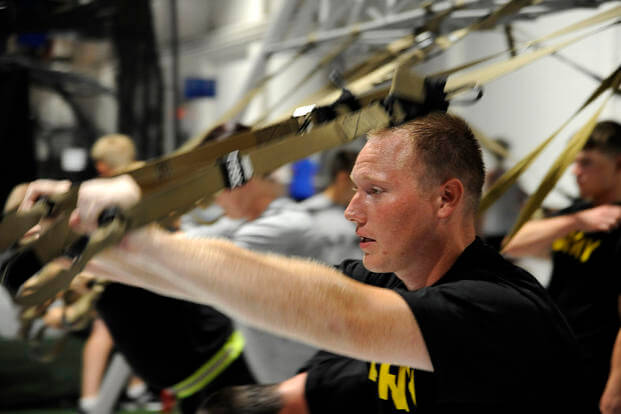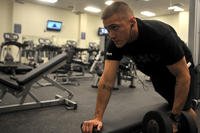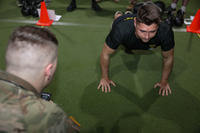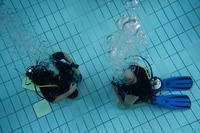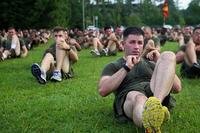Every quarter of the year, I break up my training routines to change things up and avoid staleness with workouts, as well as overtraining. Doing this, I have found that staying strong and maintaining cardiovascular fitness are maintained easily. As written in the 20 Years of Periodization, from the ages from 27-47, this has been my yearlong cycle:
- January-March: Nearly 100% weights, more non-impact cardio workouts. Ruck and swim with fins.
- April-June: Calisthenics and cardio workouts. Run/swim progression.
- July-September: Calisthenics and cardio workouts (advanced). Run max/swim progression.
- October-December: Calisthenics, weights and decrease running/non-impact cardio workouts. Ruck and swim with fins.
Here is an email from a follower of that plan who stays operational with his fire department, but is requesting some advice about changing it up.
Stew, I am a 45-year-old firefighter. I started your periodization training plan this spring and have gone from a big and slow 230 [pounds] to a leaner and more fit 210. So thanks. However, I am a little concerned with the upcoming lift cycle, as I tend to gain muscle mass (and bulk/fat) easily. I would like to work on strength, mobility and maintain current cardio levels, but I do not want to gain a lot of mass, as it has slowed me down the past 10 years. Love this system, but I need to adjust, I think. Thanks, John S.
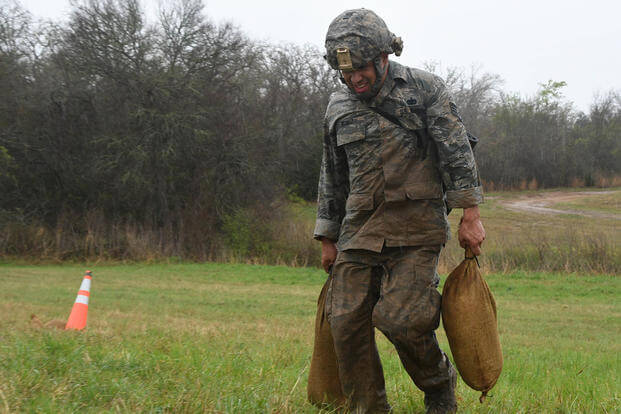
John,
A lot of firefighters are finding the TRX suspension trainer to be very useful in the firehouse for workouts between calls. With regards to making changes -- absolutely. All systems need flexibility and should adjust, if needed. My plan for the winter is doing something similar. I recommend laying off high running miles. Maybe resort to some non-impact activity, such as rowing, stair-stepping, elliptical gliding, biking, swimming, etc.
Your joints will thank you for it. However, I am doing something completely different this year as well with regards to strength training. I am reducing my high-rep calisthenics by wearing a weight vest. This will help cut my reps by 50%-75% but avoid many of the one- to two-rep maxes that made me very strong and too big last year. I got up to 225 pounds last winter, and when the spring running started, it about crushed me. After the running/high-rep cycle (and some food planning), I am back down closer to 200 pounds, where I plan to stay for good.
Another tool I am using in place of heavy barbells this winter is the TRX. I am going to use weight vests with the TRX and calisthenics as much as I can to reduce repetitions while building and maintaining strength through the winter without gaining weight. These workouts will be followed by some form of cardio workout -- short runs or non-impact options, such as rowing and swimming.
For the rest of the year, I will post on the Friday Workout of the Week my favorite TRX/weight vest/cardio workout that I created the previous week.
For example, while we are reducing our weekly run totals, we start to add different resistance training in the fall. Here is a TRX, calisthenics and carries workout we did this week.
Run one mile.
Repeat 3-4 times.
- Pull-ups max
- TRX atomic push-ups max
- TRX squats/rows 10-15
- TRX rollouts 10
- Fireman carry 50 meters or sandbag carry 100 meters
- Run one mile.
This is a quick and effective full-body workout that you can make much harder with a weight vest if you prefer and follow it with a longer, non-impact cardio workout. For instance, we swam 1,500-2,000 meters after this workout.
Yes, make changes and experiment. If your goals are to stay leaner than normal, either change up the weight and repetition ratio of the resistance training or maybe add some hard and fast interval training sessions with both resistance and cardio -- fast/slow sets or both. Regardless, at our age, our weight loss or maintenance starts in the kitchen, so eat well and don't overeat.
Stew Smith is a former Navy SEAL and fitness author certified as a Strength and Conditioning Specialist (CSCS) with the National Strength and Conditioning Association. Visit his Fitness eBook store if you're looking to start a workout program to create a healthy lifestyle. Send your fitness questions to stew@stewsmith.com.
Want to Learn More About Military Life?
Whether you're thinking of joining the military, looking for fitness and basic training tips, or keeping up with military life and benefits, Military.com has you covered. Subscribe to Military.com to have military news, updates and resources delivered directly to your inbox.
